Questionthanks, any advice you can give me on the heel command would be appreciated as Neo does not really understand (or want to understand this command). his favourite position when walking/excercising is at the end of a very strained leash.
I am also considering getting him a playmate, we want to get another husky but im not sure if getting a female or a male is best. Neo has not been castrated and we are not looking to get it done either, we had thought that if we got a female then in a few years we could breed them, however I am concerned with Neo trying to mate with her when she is still too young (he does not excessively hump at the moment, but he does fight his bed which occassionally turns into humping.) I also wanted to find out if for companionship a dog of the same sex would be better than a dog of the opposite sex.
thanks for your help
-------------------------
Followup To
Question -
I excercise my 6 month old husky by riding my bike and he runs alongside me, (on a lead) however this can be a bit dangerous, i can usually control him quite well, but it is not an option for my girlfriend to excercise him this way. can you give any advice on excercising like this or any alternative methods of high energy training that he will enjoy. i have tried to get him to pull me on a mountain board but he looses interest in pulling and waits for me to catch up with him quite often.
Answer -
Interestingly enough, my wife and I were talking about this exact thing this morning. Your best bet - the bike offers the chance for speed and will wear a husky out quicker than just about anything other than pulling a sled in snow. So, how can you do that safely on a bike? Easy - the Springer. There is another one out there, but I can't remember the name of it. But basically, the springer installs onto your bike and has a metal spring that absorbs most of the shock of the dog pulling, and also allows it to ride directly alongside of your bike. It keeps the distance away from you just safe enough that the dog shouldn't run into your bike, but close enough that the dog still feels like you are running on a "heel" command. The Springer mounts to most mountain bikes, you just need about four inches of space along the frame directly under the seat tube (not sure what the technical name for that part of the bike is, but you have your seat, the bar coming from the seat and that slides into the tube under the seat that is part of the frame. You want to be able to have 4 inches of room on the frame along that tube to attach the Springer.) If your dog has a good understanding of "heel", I use that command and both my dogs have a great time on it. The website is http://www.springerusa.com/, but Fosters & Smith I believe sells them as well. If you need any advice on getting the dog to heel, or training that way first, let me know.
AnswerWell, it sounds like the first thing that you should do is work on loose-lead walking. First, a dog constantly straining at the end of leash is problematic. It can cause damage to the throat and present several problems. I've actually met dogs that all but lost their voice because of the constant straining, and have heard stories about much worse situations. So, the only way that I've found to teach a dog not to pull is the following. First: a dog CAN pull in harness, so use that when you are running or with a bike. Second: A dog on a regular lead, CAN NOT pull. Don't go for Haltis, or harnesses, just get a good leash and a solid collar. Here's how you work loose leash training.
The dog must be taught to pay attention to the human end of the leash. Use a 6' lead, and get rid of the "flexi-leads", they don't allow the dog to understand the acceptable distance away from you that they can be. As you are walking, if the dog shoots out to the end, just before he gets there - "pop" the leash back to you. If he lags behind, at 5'11", "pop" it forward. If he lunges in front, "pop" it backwards. The "pop" should be eactly that, a sharp tug of the leash, and it should release. There should be no "pulling". If the dog yelps a little in surprise, that's a good thing. (Some do, some don't). It will scare/surprise them at first, and will be uncomfortable, but that handful of pops to get the dog to understand the distance limitations should be no problem in comparison to 12 years of pulling on the throat.
If the dog does not respond to this with a flat collar, you may need to upgrade. Responding means getting the idea of walking only in a 6' radius around you, and keeping the lead loose. Normally, most dogs get the picture really quick - about 5 mins, maybe 7 or 8 "pops" before they really start to adjust. Now, I only have to correct the dogs when they see a squirrel - just a friendly reminder that they are still attached to me. Now, the upgrade should be on the collar, to either a chain slip (choke chain) or prong collar. Believe it or not, the prong collar is much more humane, and easier to use than the choke chain. Also, chains have a habit of shaving some of the neck fur, which does nothing to harm the dog, but just looks silly. The prong collar pop tightens the prongs to pinch the neck a little. Their coats really do a ton of protection against anything more. Usually, Sibes need the prong collar to break the stubbornness. Both of our dogs use them, and they never pull unless in harness (or see a squirrel).
Now, as for the heel command, once you have the dog comfortable on a loose lead, start "teaching" the command. Any command goes through two phases. First - you teach the dog the command by not allowing the dog any choice. Give the heel command (one sharp "Heel", and I often pat my leg twice with the command) and start walking. You keep the dog at the position of heel by not allowing the dog any slack on the leash. Walk around for 10-15 seconds, and then free the dog with the release command (I use "FREE!"). Pet and praise the dog. Granted, the dog didn't do anything, but it will make sense later. You keep this up for about two weeks, gradually extending the length of time for the "HEEL" and mixing up speeds, turns, etc. Anytime you stop though, you pet and praise the dog and give the dog a command again to begin walking. It shouldn't be every walk all the time that you use this, but I used to recommend it two or three times per walk. So I might take Mika out for a 20 mins walk, and give her three commands for about 20 seconds each at some point during. Basically, you are teaching the dog that "HEEL", means stay right here. The dog has no choice to obey.
Phase two is the activation of free will. Now you have the lead loose, give the command and if the dog does it, you are fine. If not, you use the same "pops" to get the dog in position. These corrections will quickly teach the dog that "Oh, THAT'S what heel means! Ok!" And when you "free" the dog, pet and praise. This is the quickest, easiest and most reliable method to get the dog into the heel position in short order. If you need anything else, let me know!

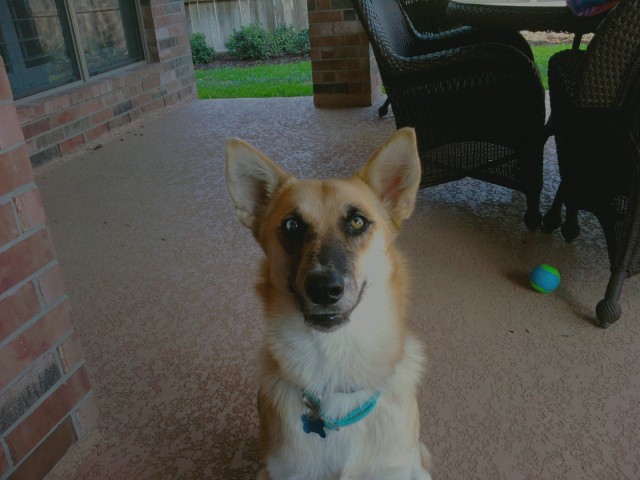 Wondering if my rescued husky mix is not a mix
Question
Ace
I adopted a 7 month old rescue abou
Wondering if my rescued husky mix is not a mix
Question
Ace
I adopted a 7 month old rescue abou
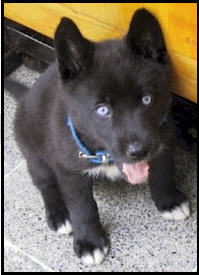 Crate Training a 7wk old Husky mix pup
QuestionHusky look-alike from
QUESTION: Weve re
Crate Training a 7wk old Husky mix pup
QuestionHusky look-alike from
QUESTION: Weve re
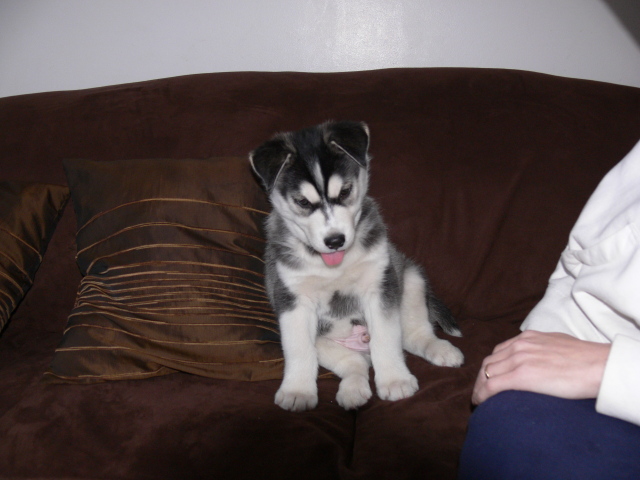 Husky Puppy Weight
Question
Zeus The Puppy
Hi we got Zeus at 6 1/2 weeks o
Husky Puppy Weight
Question
Zeus The Puppy
Hi we got Zeus at 6 1/2 weeks o
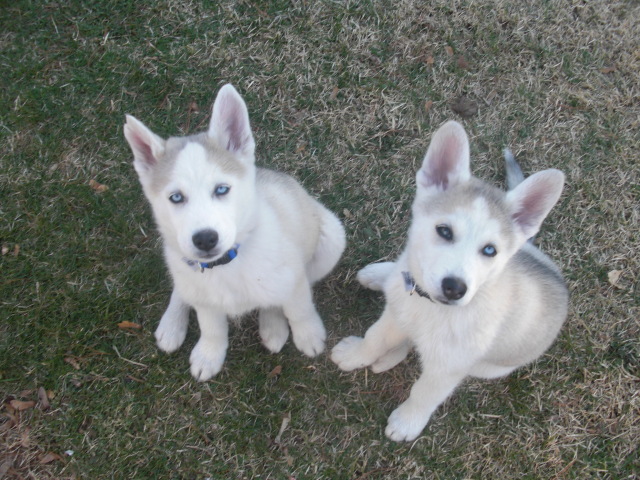 2 12 week old Husky brothers play/fighting
QuestionJasper & Sigmund
QUESTION: Two weeks
2 12 week old Husky brothers play/fighting
QuestionJasper & Sigmund
QUESTION: Two weeks
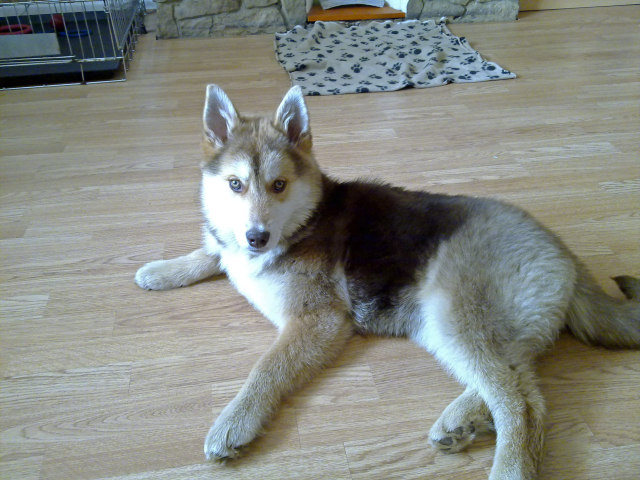 my husky colour
Question
mecca
hi i have recently got my husky mecca. s
my husky colour
Question
mecca
hi i have recently got my husky mecca. s